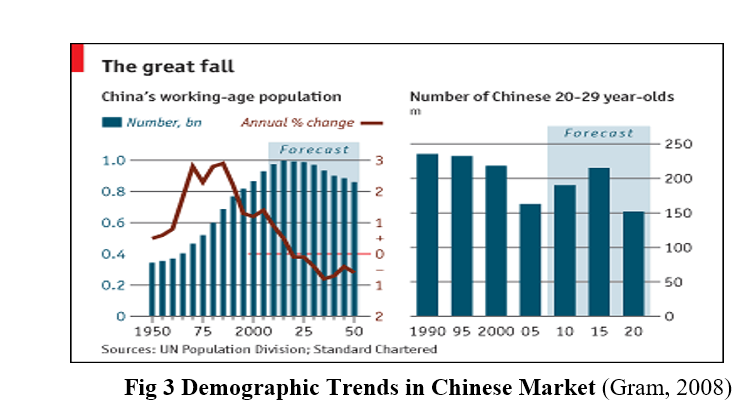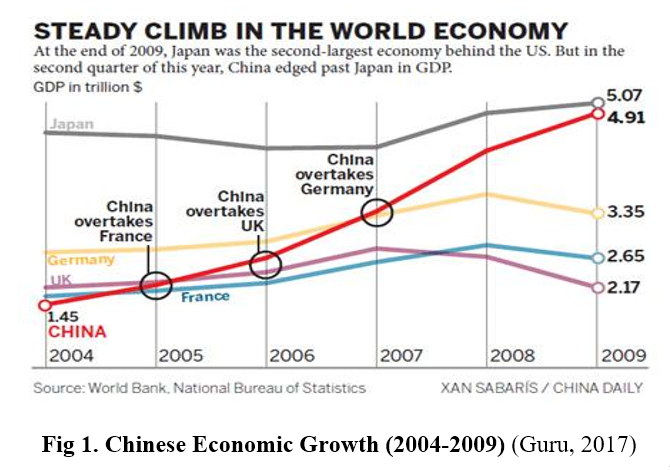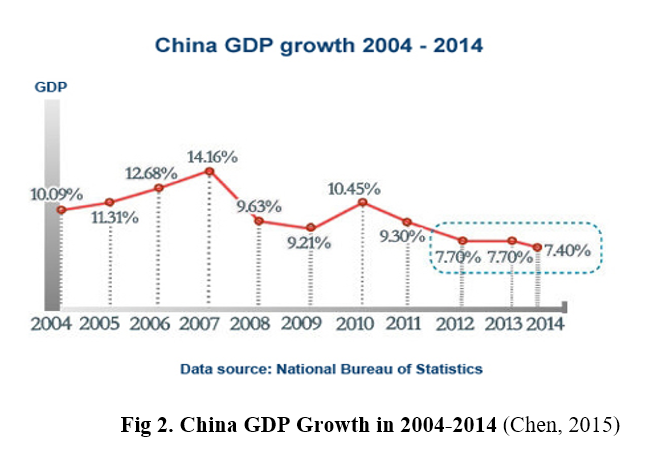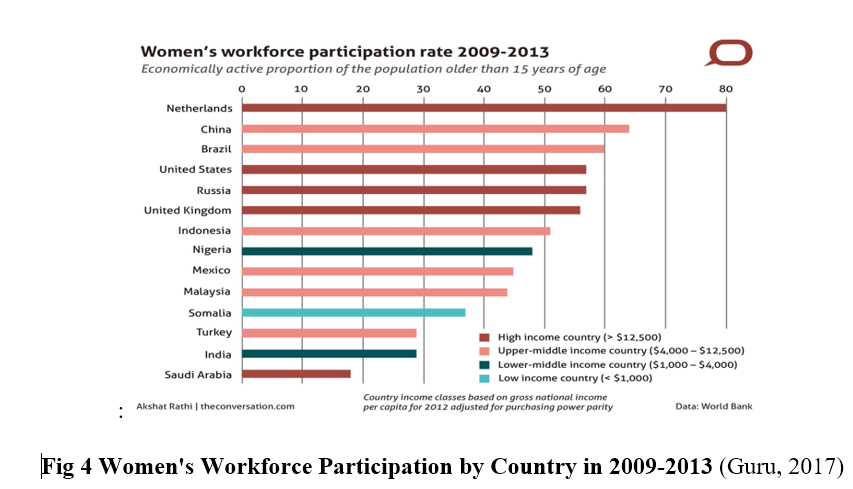The process of economic growth is a complex phenomenon, which involves a wide variety of factors, such as political, economic, social, cultural, etc. It is commonly believed that capital appears to be the primary determinant of economic growth as it drives the development of small and medium businesses. However, researchers such as Baizhu Chen and Yi Fheng consider this statement to be wrong as economic development has much to do with human resources, social environment, and political conditions (Chen & Feng, 2000).
Capital is a sufficient condition for further progress, but it is not always necessary. For instance, if you have a look at Chinese economy, it is possible to say that the implementation of open door policy in 1978 served as a defining event that initiated a free market reform. This step was a time-consuming process since it took two decades to finalize it (Yuing, 2016). Nonetheless, after 20 years of struggle, China managed to reach impressive results in the global arena.
This article aims to look at all determinants of economic growth in China, which converted the country from an impoverished introverted region into a thriving free market economy (Guru, 2017).
Role of Political Factors
According to a renowned researcher in the field of economic growth, Supriya Guru (2017), political factors drive business development. The government should be interested in economic growth and set up conducive conditions for corporations to develop inside and outside the country (Guru, 2017). If we consider Chinese case, it is possible to state that non-democratic and authoritative regime made it possible for country’s authorities to introduce European-style free market economy and maintain control over industries and political system. Total control over decision-making process allowed politicians to prevent numerous problems and eliminate risk, which led to positive results.
In 1953, the Chinese government adopted the law, which gave a right to politicians to introduce any reforms they consider to be necessary. In such way, country’s authorities implemented their Five Year Plan (2011-2016), which presupposed spending 2.2% of GDP on research and development (Yuing, 2016).
This step fostered the technological development and led to a significant improvement in production. State manufacturers could upgrade their equipment and introduced many innovations in this sphere, which enhanced the quality of the final product and attracted foreign customers (Guru, 2017).
Free Market Economy of China
As mentioned above, the transition from social market economy to open market served as a defining moment for the country. This process started in 1978 when Deng Xiaoping, Mao’s successor, decided to bring an end to Chinese isolation and introduced the reform, which attracted foreign investors to the region. It also allowed entrepreneurs to start their own business, removing price controls and privatizing state institutions.
All these actions were controlled and evaluated by the government so that politicians could take appropriate measures to avoid unfair business practices. Before the reform, the country had gone through a difficult time of Cultural Revolution, which took lives of citizens and led to severe destruction in all sphere. The Chinese ruler realized the need for significant change, which could enhance the quality of life in the country and strengthen their country’s position in the global market (Guru, 2017).
Nowadays, the Chinese economy is growing at an average of 9.5% every year, and private sector brings 70% of GDP (Yuing, 2016). The country started to interact with the external world and became members of various international organizations. For instance, in 2001, China had entered the World Trade Organization, which opened new opportunities to local corporations. This step increased international trade and fostered further economic growth (Guru, 2017). The following graph illustrated the
[dynamics of Chinese economic growth in the period between 2004-2009:
As it could be observed, in 2009, China has become third-largest economy behind the United States of America and Japan. At the end of 2009, the total GDP was estimated at $ 4,91 trillion, which is an impressive result. In a short time, the country managed to make a real breakthrough and restructure its economy (Yuing, 2016). Nonetheless, in 2010 the situation got worse due to world economic crises and severe inflation. China started to lose its position in the global arena, which had an adverse effect on its GDP. The following graph illustrates Chinese results in the period between 2004-2014:
Social Factors
Labor Supply
The Chinese population is considered to be one of the fastest growing in the world. According to the recent statistics, the country’s population was estimated at 1.3 billion. There is a plenty surplus of a cheap workforce in China, which is doubled by rural migrants. Due to the introduction of new technologies in agriculture, many employees were unemployed, which forced them to move to urban areas in search of new jobs. In 2011, it was estimated that approximately 500,000 of citizens migrated to cities from countryside and villages (Guru, 2017). Additionally, aggressive restructuring of rural areas and new manufacturing settlements initiated voluntary migration, which resulted in the surplus of cheap labor in the region. This fact attracted many international corporations, which established enterprises in the area and provided people with workplaces (Gram, 2008).
This trend was relevant for many years until Chinese working-age population has plunged over the last couple years. The country’s one-child policy introduced in 1979 restricted families from having many children. This step reduced the number of workers in the country since Chinese working-age population was used up (Gram, 2008). Additionally, the shift of employees from agriculture to industrial sectors had also slowed down. Companies begin to complain about the lack of labor and professional workers. Specialists require higher salaries since the demand for high-quality labor force has significantly increased. Jonathan Anderson, a famous economist, and writer believed that the annual growth of GDP might decline if the government does not take any measures to improve the situation in the region (Gram, 2008). The following graph illustrates the demographic trends in Chinese labor market:
Low Wages and High Unemployment Rate
The unemployment rate has significantly fallen in China over the last several years. Nonetheless, the lack of workplaces in the past attracted foreign investment from Europe and America. Professionals in China earned ten times less than their colleagues in Asia. Companies provided their workers with lower salaries, which had a positive effect on profit margin and sales figures. However, as it was mentioned before, the situation started to change over the last several years. Therefore, some international corporation, such as Nike and Adidas, decide to move their production to areas with cheap labor.
High Participation of Females in Workforce
China is the country where it is common for females to work in various industries. Chinese rate of female participation in the workforce is the highest after the Netherlands. The state’s one-child policy presupposed that women would be involved in child-raising activities for a shorter period, which would allow them to take an active part in the economic and social life of the country. In such way, females received a chance to work and allocate more time for career development. International corporation appreciate diversity since it is seen as a popular trend in the global market. This factor also attracted foreign investors and allowed companies to make their staff more diverse. The following graph represents women’s workforce participation by country (Guru, 2017).
Economic Determinants
Special Economic Zones
One of the main steps in Chinese open market policy was to encourage foreign investment that will foster economic growth in the region. For this purpose, the government created Special Economic Zones or 14 Open Cities where country’s authorities creative conducive environment for the development of international business (Yuing, 2016). Transnational Corporations were provided with tax incentives and bonuses to set up new manufacturing settlements. These organizations provided Chinese citizens with workplaces, which significantly reduced the high unemployment rate in the country. For example, EUPA, a Taiwanese manufacturer of coffee machines, is operating in one of these regions and employs approximately 25,000 workers (Yuing, 2016).
Private Entrepreneurs
Till 1970, the government did not allow citizens to start their businesses since it focused on state institutions and encouraged people to work for the country. However, after the reform was adopted, individuals received a chance to set up companies and develop own business. Nowadays, approximately 70% of all organizations are privately owned (Yuing, 2016).
Conclusion
Economic growth in China was caused by a wide range of factors. Open-market reform introduced in 1978 served an as defining moment in the history of the country. This law attracted foreign investment and opened the region for international market players. Additionally, aggressive restructuring of rural areas and voluntary migration helped to reduce wages, which allowed the international corporations to enter Chinese markets. Political factors are also significant since total control of decision-making process and internal operations allow the government to monitor the economic process and eliminate potential risks.
References
- Chen, B., & Feng, Y. (2000). Determinants of economic growth in China: Private enterprise, education, and openness. China Economic Review, 11(1), 1-15. http://dx.doi.org/10.1016/s1043-951x(99)00014-0
- Chen, Y. (2015). What Drives Long-Run Economic Growth?. Stlouisfed.org. Retrieved 22 February 2018, from https://www.stlouisfed.org/on-the-economy/2015/june/what-drives-long-run-economic-growth
- Gram, D. (2008). Reserve army of underemployed. The Economist. Retrieved 22 February 2018, from http://www.economist.com/node/12052315
- Guru, S. (2017). Factors that Determine Economic Growth and Development of a Country. Your Article Library. Retrieved 22 February 2018, from http://www.yourarticlelibrary.com/economics/factors-that-determine-economic-growth-and-development-of-a-country/38250
- Yuing, L. (2016). New normal of the Chinese economy – Chinadaily.com.cn. Chinadaily.com.cn. Retrieved 22 February 2018, from http://www.chinadaily.com.cn/opinion/2014-10/10/content_18716671.htm






I think you have remarked some very interesting details , thanks for the post.
My partner and I stumbled over here by a different web page and thought I should check things out. I like what I see so now i’m following you. Look forward to looking into your web page repeatedly.
naturally like your web-site however you need to test the spelling on quite a few of your posts. A number of them are rife with spelling issues and I in finding it very bothersome to tell the reality then again I’ll surely come again again.
I?¦ve been exploring for a little for any high quality articles or blog posts in this kind of space . Exploring in Yahoo I finally stumbled upon this site. Reading this info So i?¦m glad to show that I’ve an incredibly just right uncanny feeling I found out exactly what I needed. I such a lot indisputably will make certain to do not put out of your mind this site and provides it a look regularly.
Hi! This is my 1st comment here so I just wanted to give a quick shout out and say I really enjoy reading your articles. Can you suggest any other blogs/websites/forums that deal with the same subjects? Many thanks!
I’ve been exploring for a little for any high-quality articles or blog posts in this kind of house . Exploring in Yahoo I eventually stumbled upon this site. Reading this info So i am happy to show that I have a very excellent uncanny feeling I found out exactly what I needed. I so much for sure will make sure to do not forget this site and provides it a glance regularly.
You made some good points there. I did a search on the subject and found most people will agree with your website.
I haven?¦t checked in here for some time as I thought it was getting boring, but the last few posts are great quality so I guess I?¦ll add you back to my daily bloglist. You deserve it my friend 🙂
Lovely just what I was looking for.Thanks to the author for taking his time on this one.
3ue8sw
Your style is so unique compared to many other people. Thank you for publishing when you have the opportunity,Guess I will just make this bookmarked.2
I wanted to thank you for this great read!! I definitely enjoying every little bit of it I have you bookmarked to check out new stuff you post…
The next time I read a blog, I hope that it doesnt disappoint me as much as this one. I mean, I know it was my choice to read, but I actually thought youd have something interesting to say. All I hear is a bunch of whining about something that you could fix if you werent too busy looking for attention.
cfvn8e
I?¦ll right away grab your rss as I can not in finding your e-mail subscription link or newsletter service. Do you’ve any? Kindly let me recognise so that I could subscribe. Thanks.
I have been absent for some time, but now I remember why I used to love this site. Thanks, I?¦ll try and check back more frequently. How frequently you update your web site?
Just wanna comment on few general things, The website style is perfect, the subject material is real good : D.
What a great story! I’m so glad you shared it. The data you supplied was both practical and simple to grasp. Your ability to simplify otherwise difficult ideas is much appreciated. Anyone interested in learning more about this subject would benefit greatly from reading this.
jc2eig
2su1bz